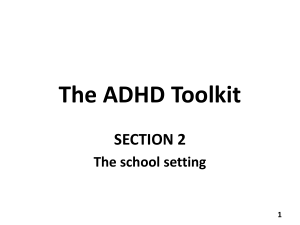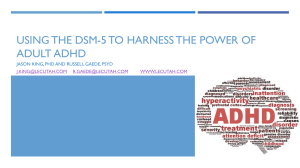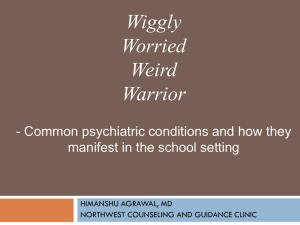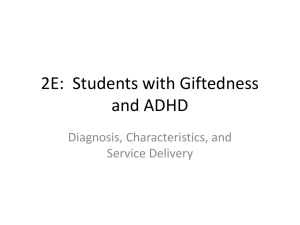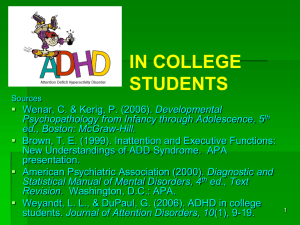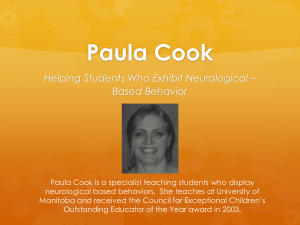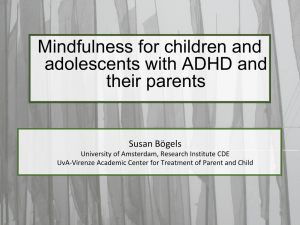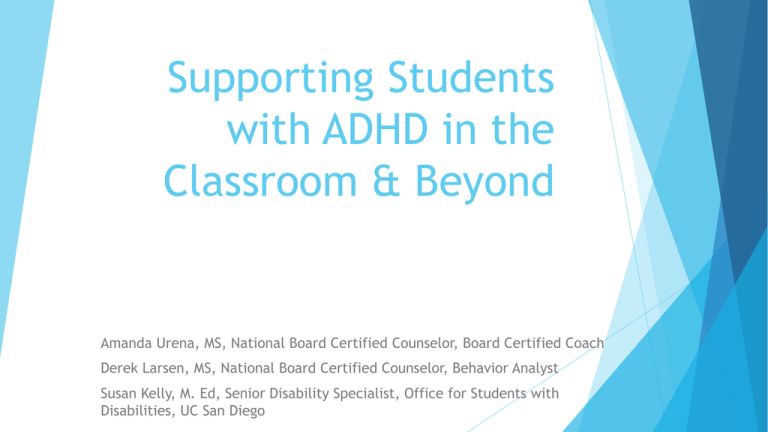
Supporting Students
with ADHD in the
Classroom & Beyond
Amanda Urena, MS, National Board Certified Counselor, Board Certified Coach
Derek Larsen, MS, National Board Certified Counselor, Behavior Analyst
Susan Kelly, M. Ed, Senior Disability Specialist, Office for Students with
Disabilities, UC San Diego
Overview ADHD
Introduction & Statistics
Symptoms & Diagnosis
Tools & Strategies Inside the Classroom
Tools & Strategies Outside the Classroom
Community Resources
UCSD Campus Resources
ADHD Diagnosis &
Academic Tools & Strategies
Amanda Urena, MS, National Board Certified Counselor, Board Certified Coach
Derek Larsen, MS, National Board Certified Counselor, Behavior Analyst
ADHD Defined
Attention Deficit/Hyper Activity Disorder is a neurodevelopmental disorder that can
develop in both children and adults, according to The American Psychiatric
Association's Diagnostic and Statistical Manual, 5th edition or “DSM V” (American
Psychiatric Association, 2013)
In the 20th century, ADHD was largely believed to be a condition affecting
prominently children. Diagnostic criteria from the DSM II from 1968, reported ADHD
“usually diminishes by adolescence’’ (American Psychiatric Association, cited by
Barkley, 2006)
Revisions to the latest DSM V in 2013 have included diagnostic criteria for teens and
adults to be more thoroughly diagnosed with ADHD (American Psychiatric
Association, 2013)
ADHD Statists in the United States: Children
National Survey of Children's Health from The Center for Disease Control & Prevention and
The Health Resources & Services, collected every four years from parent reports found:
5.1 million children or 1 in 11 children 4-17 years old have a diagnosis of ADHD in 2011
ADHD Diagnosis by Sex:
1 in 5 high school boys
1 in 11 high school girls
ADHD Diagnosis by Race-Ethnicity:
Higher percentages of White and African-American children have ADHD than in HispanicLatino children (Visser, Danielson, Bitsko, Holbrook, Kogan, Ghandour, . . . Blumberg,
2014).
ADHD Statists in the United States: Children
National Survey of Children's Health from The Center for Disease Control & Prevention
and The Health Resources & Services, collected every four years from parent reports
found:
Percentages of US Children 4-17 years-old to have ever received a diagnosis of ADHD
by a heath care provider, according to parent reports:
11% in 2011
•
9.5 % in 2007
•
7.8 % in 2007
(Visser et al, 2014)
ADHD Statists in the United States: Children
A 2004 study found 25% of children with ADHD, have the diagnosis persists into
adulthood (Faraone SV, Spencer TJ, Montano CB, 2004)
National Comorbidity Survey Replication found:
•
4.4% of adults have a diagnosis of ADHD, according to self-reports, in 2006
Sex of Respondents Diagnosed with ADHD
•
61.6% male
•
38.4% female
Race-Ethnicity Respondents Diagnosed with ADHD
•
81.8% Non-Hispanic White
•
7.5% Hispanic
•
6.2 Black
•
4.5 Other
(Kessler, Adler, Barkley, Biederman, Conners, Demler, … Zaslavsky, 2006)
ADHD Diagnosis
Doctors and mental health professionals such as licensed therapists,
social workers, and psychologists use The American Psychiatric
Association's Diagnostic and Statistical Manual, Fifth edition (DSM V) to
diagnose mental heath issues
The current DSM-V was released in May 2013
The DSM-V included several updates to the previously established
criteria for ADHD from the DSM-IV
•
More accurately encompasses teens and adults with ADHD (previous
emphasis on children)
•
Symptoms can appear in children by age 12 (was previously age 7)
•
Includes a co-morbid disorder with Autism Spectrum Diagnosis
(American Psychiatric Association, 2013)
DSM V Diagnostic Criteria ADHD
A. “A persistent pattern of inattention and/or hyperactivity- impulsivity that
interferes with functioning or development, as characterized by:”
(1)
Inattention and/or
(2)
Hyperactivity
Children under 17
• “Six (or more) symptoms have persisted for at least 6 months
to a degree that is inconsistent with developmental level and that negatively
impacts directly on social and academic/occupational activities.”
Note: “The symptoms are not solely a manifestation of oppositional behavior, defiance, hostility or
failure to understand tasks or instructions.” (American Psychiatric Association, 2013)
Age 17 & older (Adults)
•
Five symptoms are required.
(American Psychiatric Association, 2013)
DSM V Diagnostic Criteria ADHD
B. “Several inattentive or hyperactive - impulsive symptoms were present prior
to age 12 years.”
C. “Several inattentive or hyperactive-impulsive symptoms are present in two or
more settings (e.g., at home, school or work; with friends or relatives; in other
activities).”
D. “There is clear evidence that the symptoms interfere with, or reduce the
quality of, social, academic or occupational functioning.”
E. “The symptoms do not occur exclusively during the course of schizophrenia or
another psychotic disorder and are not better explained by another mental
disorder (e.g., mood disorder, anxiety disorder, dissociative disorder, personality
disorder, substance intoxication or withdrawal).”
(American Psychiatric Association, 2013)
DSM V Diagnostic Criteria ADHD-Inattention
A. “Often fails to give close attention to details or makes careless mistakes in
schoolwork, at work or during other activities (e.g., overlooks or misses details, work
is inaccurate).”
B. “Often has difficulty sustaining attention in tasks or play activities (e.g., has
difficulty remaining focused during lectures, conversations or lengthy reading).”
C. “Often does not seem to listen when spoken to directly (e.g., mind seems
elsewhere, even in the absence of any obvious distraction).”
D. “Often does not follow through on instructions and fails to finish schoolwork,
chores or duties in the workplace (e.g., starts tasks but quickly loses focus and is
easily sidetracked).”
E. “Often has difficulty organizing tasks and activities (e.g., difficulty managing
sequential tasks; difficulty keeping materials and belongings in order; messy,
disorganized work; has poor time management; fails to meet deadlines).”
(American Psychiatric Association, 2013)
DSM V Diagnostic Criteria ADHD-Inattention
F. “Often avoids, dislikes, or is reluctant to engage in tasks that require
sustained mental effort (e.g., schoolwork or homework; for older adolescents
and adults, preparing reports, completing forms; reviewing lengthy papers).”
G. “Often loses things necessary for tasks or activities (e.g. school materials,
pencils, books, tools, wallets, keys, paperwork, eyeglasses, mobile
telephones).”
H. “Is often easily distracted by extraneous stimuli (for older adolescents and
adults, may include unrelated thoughts).”
I. “Is often forgetful in daily activities (e.g., doing chores, running errands; for
older adolescents and adults, returning calls, paying bills, keeping
appointments).”
(American Psychiatric Association, 2013)
DSM V Diagnostic Criteria ADHD- Hyperactive-Impulsive
A. “Often fidgets with or taps hands or feet or squirms in seat.”
B. “Often leaves seat in situations when remaining seated is expected (e.g.,
leaves his or her place in the classroom, in the office or other workplace, or in
other situations that require remaining in place).”
C. “Often runs about or climbs in situations where it is inappropriate. (Note:
In adolescents or adults, may be limited to feeling restless.)
D. “Often unable to play or engage in leisure activities quietly.”
E. “Is often “on the go”, acting as if “driven by a motor” (e.g., is unable to be
or uncomfortable being still for extended time, as in restaurants, meetings;
may be experienced by others as being restless or difficult to keep up with).”
(American Psychiatric Association, 2013)
DSM V Diagnostic Criteria ADHD-Hyperactive-Impulsive
F. “Often talks excessively.”
G. “Often blurts out an answer before a question has been completed
(e.g. , completes people’s sentences; cannot wait for turn in
conversation).”
H. “Often has difficulty waiting his or her turn (e.g., while waiting in
line).”
I. “Often interrupts or intrudes on others (e.g. butts into conversations,
games or activities; may start using other people’s things without asking
or receiving permission: for adolescents and adults, may intrude into or
take over what others are doing).”
(American Psychiatric Association, 2013)
ADHD Diagnosis
Specify whether:
1. “Combined presentation”:
• If both criterion for inattention and criterion for hyperactivity impulsivity are met for the past 6 months.
2. “Predominantly inattentive presentation”:
• If criterion for inattention is met, but criterion for hyperactivityimpulsivity is not met for the past 6 months.
3. “Predominantly hyperactive/impulsive presentation”:
• If criterion for hyperactivity -impulsivity is met, but criterion for
inattention is not met for the past 6 months).
Further Specifies:
• In partial remissions
• Severity: Mild, Moderate or Severe
(American Psychiatric Association, 2013)
Co-Morbid/Co-occurring Conditions with ADHD
Several studies found over 50% of people diagnosed with AHDH also
have a secondary diagnosis. (Biederman, Newcorn, Sprich, 1991;
Jensen, Martin, Cantwell, 1997)
Common co-occurring diagnoses include:
•
Anxiety
•
Major depression
•
Conduct Disorder (children)
•
Tourette Syndrome
•
Substance Abuse Disorder
•
Learning Disorders
(Biederman et al, 1991; Biederman, Faraone, Spencer, Wilens,
Norman, Lapey, . . . Doyle, 1993)
20%-25% of ADHD children meet criteria for a learning disorder
(Pliszka SR, 1998)
Executive Functions
Executive functions can be impaired in Individuals with ADHD, as described in
the DSM-V symptoms of ADHD
Dr.Thomas Brown, Yale Clinic for Attention and Related Disorders, Yale
University defines executive functions as:
• “..a wide range of central cognitive functions that play a critical role for
all individuals as they manage multiple tasks of daily life (1). “
Brown’s model includes six categories of impairments in cognitive function
1) Activation-organizing, prioritizing, beginning tasks, estimating time
2) Focus- maintaining focus, shifting topics
3) Effort- maintaining effort for long-term tasks, processing speed issues
4) Emotion*- regulating emotion *(not a symptom in DSM)
5) Memory- recalling information
6) Action- regulating activities (impulsivity)
(Brown, 2009)
Tools & Strategies: Inside the Classroom
Improving attention to detail:
•
Follow directions using a ruler, piece of paper or post-it to thus be
able to read instructions line by line
•
Ask clarifying questions
•
Using highlighters, underlining, making notations, or re-writing
directions for increased understanding
•
Review work prior to turning in
•
Be mindful of how long tasks take you (to avoid rushing through)
Tools & Strategies: Inside the Classroom
Improving attention to detail:
•
Break down directions sequentially and/or multi-step
•
Ex: Complete the following essay:
“Do small dogs stimulate or hinder the economic growth of San Diego? Include
5-7 examples to support your assertion. Be sure to include statistics from
chapter 7 of All Dogs Go to San Diego.”
•
Ex: Complete the following essay (with directions rewritten):
1) “Do small dogs stimulate or hinder the economic growth of San Diego?”
2) “Include 5-7 examples to support your assertion.”
3) “Be sure to include statistics from chapter 7 of All Dogs Go to San Diego.”
Tools & Strategies: Inside the Classroom
Improving attention span:
•
Proximity control: sit at a location in the room where you will be
able to focus best, that reduces distractions to external stimuli
•
Put away cellphone
•
Use of music (words or no words)
•
Draw in margins
•
Utilize breaks
•
Request to take tests in separate location
Tools & Strategies: Inside the Classroom
Improving task completion
•
Extended time accommodation (ex: 25% more time given, 50% more
time given)
•
A 2011 study found extended time improved the reading scores of
adolescents with ADHD
o
o
Testing under standard time conditions:
•
53% of adolescents finished the reading comprehension test
•
42.8% were able to score within 1 SD of their IQ verbal
comprehension index (VCI).
Testing under extended time:
•
77.9% of adolescents were able to score within 1 SD of their
VCI
(Brown, Reichel, & Quinlan, 2011)
Tools & Strategies: Inside the Classroom
Improving task completion
•
Create a step-by-step “to do” list or check list before engaging in activity
o Check off/cross out steps as completed
o Highlight those steps that need to still be completed
•
Directions written as a checklist:
Ex: ____ Read the “Abra Cadabra” poem
____ Find all metaphors within the poem and be ready to discuss
____ Complete a one page reaction to the poem
____ Underline the hyperboles
Tools & Strategies: Inside the Classroom
Improving memory
•
Keep an assignment book (paper or electronic) for homework,
projects, studying for tests
•
Write down any verbal directions
•
Keep written notes with you
•
Text or email self reminders
Tools & Strategies: Inside the Classroom
Improving comprehension-Note taking
•
Experiment with different styles of note taking
•
Know what style of note taking works best for you!
•
Use colored pens to separate out ideas and/or chunk information
•
Draw pictures or symbols, or other codes
o
Ex: Using ??? for information that needs further review, or
professor clarification
o
Ex: Using
on the test
for information that highlights information that is
•
Use post-its
•
Have highlighters ready
•
Use a computer to type notes
Tools & Strategies: Inside the Classroom
Maintaining in a physical location for long periods
•
Find a way of moving a part of your body discreetly
o Ex: Shake leg or tap knee
•
Use of a stress ball, or other tactile aid
•
Stand if needed and/or give self certain space to pace about
•
Take a break when needed
•
Wear a watch
Tools & Strategies: Inside the Classroom
Improving understanding of appropriate timing
•
While someone is talking, try to listen for the end of his/her
sentence/point before chiming in
•
If you have already contributed to a conversation, count a few
seconds before chiming in again to give others a chance to contribute
•
Write down short notes of the comment you want to say (so you both
wait and don’t forget)
•
Apologize for interrupting and allow person to finish thought first
•
Raise hand or knock before speaking (when appropriate)
Tools & Strategies: Outside the Classroom
Improving task completion & time management: Projects
•
•
Put all projects, tests and syllabi on a calendar at the start of the
semester
o
Color coordinate materials per subject and with text/ink color on
calendar
o
Include major personal commitments (ex: birthdays, ect)
Break down projects into multi-step components
o
Assign deadline dates
o
Add dates to the calendar
Tools & Strategies: Outside the Classroom
Improving task completion & improving focus/restlessness-Homework
•
Setting up study area(s)
o
Academics:
•
o
Pens, pencils, highlighters, hole punch, hard surface, etc
Distractibility:
•
Put away cellphone & other distractions
•
Clear off debris
•
Noise cancelling headphones/earplugs
Tools & Strategies: Outside the Classroom
Improving task completion & Improving focus/restlessness-Homework
•
Setting up a study area(s) (continued)
o
o
Focus:
•
Use of a stress ball, or other tactile aid
•
Use of music or white noise (ex: fan)
•
Drink
Inspiration:
•
Inspirational signs or quotes
•
Positive thinking
Tools & Strategies: Outside the Classroom
Improving task completion-Homework
•
Study area outside of home:
o
Find a places to study that minimizes distractions
o
Options outside of home (ex: library, café, food court)
o
Have multiple options
Tools & Strategies: Outside the Classroom
Improving task completion & Improving focus/restlessness-Homework
Take breaks
•
o
Set a timer (for working periods and break)
o
Pick a break activity that will minimize further distractions
Use of a timer to self-pace:
•
•
o
Audible alarm or vibrating alarm
o
Visual cues (ex: “Where is my focus?” “Am I on task?”)
2014 study of adolescents who used a vibrating self-monitoring device found:
o
Bell work increased
o
Independent work production increased
(Morrison, C., McDougall, D., Black, R. & King-Sears, M., 2014)
Tools & Strategies: Outside the Classroom
Improving task completion
•
Understand self to know how long a task will actually take you
o
Time yourself when completing tasks
•
Believe you can finish the task
•
Reward yourself for completion of difficult tasks
Tools & Strategies: Outside the Classroom
Improving task completion & memory
•
Use of a small notebook to record daily “to-do” list for next day
•
Use of post-it/sign for urgent task(s) clipped to bag, backpack or keys
•
Use of checklist for multi-step tasks
o
Make the start of the task easier
•
o
(ex: If need to ask a librarian a question the next day, write
down the li brary’s phone number on piece of paper)
Begin the task
Tools & Strategies: Outside the Classroom
Improving organization
•
Color coordinate notebooks, binders and folders
•
Use of a separate homework folder
•
Schedule a weekly or monthly cleanout of materials from binder
•
o
Put cleaning date on calendar
o
Use of a hole punch
Have a “home” for school materials when not in use
US Laws
1973 US Rehabilitation Act -Section 504
•
Prohibits discrimination based on disability in federal institutions or
organizations who receive federal funds
•
Reasonable accommodations must be provided to support individuals
with documented disabilities
(Your Rights under Section 504 of the Rehabilitation Act, 2006)
1990 Americans With Disabilities Act
•
“The ADA prohibits discrimination on the basis of disability in
employment, State and local government, public accommodations,
commercial facilities, transportation, and telecommunications. It also
applies to the United States Congress.”
•
Reasonable accommodations must be provided to support individuals
with documented disabilities
(A Guide to Disability Rights Laws, 2007)
Treatment Options
Counseling
•
A licensed mental health counselor or licensed social worker
•
Support clients with emotional, social aspects of ADHD
•
Behavior therapy
Coaching
•
A certified ADHD/Life Coach
•
Support clients with academic, career, organizational aspects of ADHD
Medication
•
A licensed psychiatrist or general family practitioner
•
Prescription
Community Resources
Children and Adults with Attention-Deficit/Hyperactivity Disorder (CHADD)
•
http://www.chadd.org
•
A national nonprofit organization
•
“Improves the lives of people affected by ADHD through education, advocacy, and
support.” (Mission Statement. Retrieved from http://www.chadd.org/AboutCHADD/Mission-and-History.aspx)
•
Local Chapter-San Diego http://www.chadd.net/template.cfm?affid=403&p=about
National Alliance on Mental Health
http://www.nami.org
•
A national nonprofit organization
•
“Advocates for access to services, treatment, supports and research and is
steadfast in its commitment to raise awareness and build a community for hope
for all of those in need.” (About Nami. Retrieved from
http://www.nami.org/template.cfm?section=About_NAMI)
o
Local Chapter-San Diego http://www.namisandiego.org/
UCSD Resources
Counseling & Psychological Services (CAPS)
•
ADHD Support Group
•
A 4 week group, covering topics related to ADHD. Participants
share experiences, strengths and strategies for success with ADHD.
•
http://caps.ucsd.edu/
Office for Students with Disabilities (OSD)
•
http://disabilities.ucsd.edu
Office for Students with
Disabilities
Susan Kelly, M. Ed.
Senior Disability Specialist
What does the OSD do?
Meet with students to engage in the interactive
process
Review medical documentation
Determine reasonable accommodations
Collaborate with faculty and staff
Conditions OSD Accommodates
Permanent Conditions
•
Mobility
•
Sensory (hearing/vision)
•
Chronic Health (MS, CP)
•
Mental Health (anxiety, depression)
•
Learning Disabilities/ADHD
Temporary Conditions
•
Surgery or sudden, serious injury or illness
Fractures to upper and/or lower limbs
• Concussions
•
Process to Obtain Accommodations
Complete Intake and consent forms (on-line)
Make an appointment
Submit documentation
Meet with an OSD Disability Specialist
Who determines accommodations and how is this done?
Documentation review committee
Based on current functional limitations
Accommodations provided in 4 areas:
•
Classrooms and labs
•
Exams and quizzes
•
Campus living
•
Program modification
Communicating Accommodations
Authorization for Accommodation (AFA) letter is issued by
the OSD to the student
Students must share AFA letter with faculty, TA, and OSD
Academic Liaison and request accommodations
•
OSD informs students they should schedule an
appointment to meet with faculty in their offices. This
protects the student’s confidentiality while providing
an opportunity for the student and faculty to discuss
how accommodations will be arranged and course
expectations.
Important Reminders
Confidentiality
Syllabus
statement
Appropriate
Setting
questions to ask
precedents
Accommodations
Contact
for teaching assistants
the OSD if you have questions
Where is the OSD?
University Center 202 (behind Center Hall)
Contact Information
•
858.534.4382
•
osd@ucsd.edu
•
http://disabilities.ucsd.edu
Works Cited
About Nami. Retrieved from
http://www.nami.org/template.cfm?section=About_NAMI
American Psychiatric Association. (1968). Diagnostic and statistical manual of
mental disorders (2nd ed.) Washington, DC: Author.
American Psychiatric Association. (2013). Diagnostic and statistical manual of
mental disorders (5th ed.) Washington, DC: Author.
Barkley, R. A. (2006). Attention-deficit Hyperactivity Disorder. A Handbook for
Diagnosis and Treatment (p. 50). New York: Guilford
Biederman, J., Newcorn, J., Sprich, S. (1991). Comorbidity of attention deficit
hyperactivity disorder with conduct, depressive, anxiety and other disorders.
American Journal of Psychiatry, 148 (5), 564-577.
Works Cited
Biederman, J., Faraone, S.V., Spencer, T., Wilens, T., Norman, D., Lapey, K.A., . . .
Doyle, A. (1993). Patterns of psychiatric comorbidity, cognition, and
psychosocial functioning in adults with attention deficit hyperactivity disorder.
American Journal of Psychiatry, 150 (12), 1792-1798.
Brown, T.E. (2009). ADD/ADHD and impaired executive function in clinical
practice. Current Attention Disorder Reports 2009, 1, 37–41.
Brown, T, Reichel, P.R, Quinlan, D.M. (2011). Extended time improves reading
comprehension test scores for adolescents with ADHD. Open Journal of
Psychiatry, 1, 79-87.
CHADD Mission Statement. Retrieved from
http://www.chadd.org/About-CHADD/Mission-and-History.aspx
Works Cited
Faraone, S.V., Spencer, T.J., Montano, C.B. (2004). Attention-deficit/hyperactivity
disorder in adults: a survey of current practice in psychiatry and primary care.
Archives of Internal Medicine, 164 (11), 1221–1226.
Guide to Disability Rights Laws. (2007). Retrieved from
http://www.ada.gov/cguide/htm
Jensen, P.S., Martin, D., Cantwell, D. (1997). Comorbidity in adhd: implications for
research, practice, and dsm-v. Journal of the American Academy of Child and
Adolescent Psychiatry, 36 (8), 1065–1079.
Kessler, R.C., Adler, L., Barkley, R., Biederman, J., Conners, C.K., Demler, O.,
Zaslavsky, A.M. (2006). The prevalence and correlates of adult adhd in the
united states: results from the national comorbidity survey replication. The
American Journal of Psychiatry, 163(4), 716–723.
Works Cited
Morrison, C., McDougall, D., Black, R., King-Sears, M. (2014). Impact of tactile-cued
self-monitoring on independent biology work for secondary students with
attention deficit hyperactivity disorder. Journal of College Teaching &
Learning. 11 (4), 181- 196.
Pliszka, S.R. (1998). Comorbidity of attention-deficit/hyperactivity disorder with
psychiatric disorder: an overview. Journal of Clinical Psychiatry, 59 (7), 50-58.
Visser, S.N., Danielson M.L., Bitsko R.H., Holbrook, J.R., Kogan, M.D., Ghandour,
R.M., . . . Blumberg, S.J. (2014). Trends in the parent-report of health care
provider-diagnosed and medicated attention-deficit/hyperactivity disorder.
Journal of the American Academy of Child and Adolescent Psychiatry, 53 (1),
34-46.
Your Rights under Section 504 of the Rehabilitation Act. (Rev. 2006). Retrieved from
http://www.hhs.gov/ocr/civilrights/resources/factsheets/504.pdf




